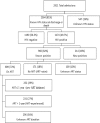Inpatient mortality rates during an era of increased access to HIV testing and ART: A prospective observational study in Lilongwe, Malawi
- PMID: 29415015
- PMCID: PMC5802850
- DOI: 10.1371/journal.pone.0191944
Inpatient mortality rates during an era of increased access to HIV testing and ART: A prospective observational study in Lilongwe, Malawi
Abstract
Background: In the era of increased access to HIV testing and antiretroviral treatment (ART), the impact of HIV and ART status on inpatient mortality in Malawi is unknown.
Methods: We prospectively followed adult inpatients at Kamuzu Central Hospital medical wards in Lilongwe, Malawi, between 2011 and 2012, to evaluate causes of mortality, and the impact of HIV and ART status on mortality. We divided the study population into five categories: HIV-negative, new HIV-positive, ART-naïve patients, new ART-initiators, and ART-experienced. We used multivariate binomial regression models to compare risk of death between categories.
Results: Among 2911 admitted patients the mean age was 38.5 years, and 50% were women. Eighty-one percent (81%) of patients had a known HIV status at the time of discharge or death. Mortality was 19.4% and varied between 13.9% (HIV-negative patients) and 32.9% (HIV-positive patients on ART ≤1 year). In multivariable analyses adjusted for age, sex and leading causes of mortality, being new HIV-positive (RR = 1.64 95% CI: 1.16-2.32), ART-naive (RR = 2.28 95% CI: 1.66-2.32) or being a new ART-initiator (RR = 2.41 95% CI: 1.85-3.14) were associated with elevated risk of mortality compared to HIV-negative patients. ART-experienced patients had comparable mortality (RR = 1.33 95% CI: 0.94-1.88) to HIV-negative patients.
Conclusion: HIV related mortality remains high among medical inpatients, especially among HIV-positive patients who recently initiated ART or have not started ART yet.
Conflict of interest statement
Figures
References
-
- Palella Jr. FJ, Baker RK, Moorman AC, Chmiel JS, Wood KC, Brooks JT, et al. Mortality in the highly active antiretroviral therapy era: changing causes of death and disease in the HIV outpatient study. J Acquir Immune Defic Syndr. 2006;43(1):27–34. doi: 10.1097/01.qai.0000233310.90484.16 - DOI - PubMed
-
- Zachariah R, Fitzgerald M, Massaquoi M, Pasulani O, Arnould L, Makombe S, et al. Risk factors for high early mortality in patients on antiretroviral treatment in a rural district of Malawi. AIDS. 2006;20(18):2355–60. doi: 10.1097/QAD.0b013e32801086b0 - DOI - PubMed
-
- Akinkuotu a, Roemer E, Richardson a, Namarika DC, Munthali C, Bahling a, et al. In-hospital mortality rates and HIV: a medical ward review, Lilongwe, Malawi. Int J STD AIDS. 2011;22(8):465–70. doi: 10.1258/ijsa.2011.011021 - DOI - PubMed
-
- Lewden C, Salmon D, Morlat P, Bévilacqua S, Jougla E, Bonnet F, et al. Causes of death among human immunodeficiency virus (HIV)-infected adults in the era of potent antiretroviral therapy: Emerging role of hepatitis and cancers, persistent role of AIDS. Int J Epidemiol. 2005;34(1):121–30. doi: 10.1093/ije/dyh307 - DOI - PubMed
-
- Coetzee D, Hildebrand K, Boulle A, Maartens G, Louis F, Labatala V, et al. Outcomes after two years of providing antiretroviral treatment in Khayelitsha, South Africa. AIDS. 2004. April 9;18(6):887–95. - PubMed
Publication types
MeSH terms
Substances
Grants and funding
LinkOut - more resources
Full Text Sources
Other Literature Sources
Medical


